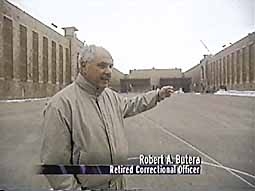![[NYCHS Shield]](../../images/nychshd6.gif) ![[thclogo]](thclogo.gif) intoThe Citizen's front page story on The History Channel's The Big House: Auburn premiere Aug. 29, 2003 NYCHS, whose mission includes promoting NY correction history, has assisted in different ways and on various projects THC researchers and producers. THC alerted NYCHS to the Auburn CF documentary's May premiere. At NYCHS' request, THC provided an advance tape from which NYCHS captured images and used them, with permission, to post on this site a web "preview" of the show. The Citizen reporter learned of it and contacted NYCHS.
 From The Citizen of May 14, 2003:History Channel to air documentary on Auburn Correctional Facility
By Erik Sorenson
AUBURN - A documentary on the history of Auburn Prison has been locked away for more than two years. But on May 29, stories from the imposing structure on State Street will finally air on The History Channel. Producer Edgar Sotomayar of Greystone Communications in New York City came upstate in late March 2001, to film inside the now-named Auburn Correctional Facility for three days. The editing was completed that summer. For Thomas C. McCarthy, who designed and updates the Web site for the New York Correction History Society, the wait was worth it. "I think it was one of the best pieces I've ever seen, considering the fact that you're dealing with something that goes back to 1817," McCarthy. "It's an absolutely terrific piece." Dolores Gavin, the manager of programming for The History Channel and the supervisor of The Big House series, said the program on Auburn Prison was delayed because better known prisons -- such as Leavenworth, Attica, San Quentin, and Folsom -- were featured first on The Big House. But she's pleased with how the documentary turned out. A former journalist and public information officer for the [NYC] Department of Correction, McCarthy appreciates that Sotomayar did not sensationalize some of the more headline-grabbing moments in the prison's history. "I've seen some prison documentaries which I think were very exploitive, and some that are not balanced. I liked the historical perspective that was done here," McCarthy said. "And given the fact they had to cover so much history, I was very impressed with it." Just two years after Auburn was incorporated as a village, the prison took in its first 57 prisoners in 1817. McCarthy said the documentary charts how different prison reforms began at the facility, and how the "Auburn System" changed the way prisons were run not only in New York, but throughout the world. The Auburn System did away with having prisoners in solitary confinement every hour of every day. Instead, prisoners would be locked up at night, but allowed out during the day for hard labor. Convicts marched in lock-step, wore new uniforms with broad white and black stripes, and were strictly forbidden to speak, or they would be whipped. McCarthy admitted Auburn Prison is probably best known for installing the world's first electric chair. One of the state's blue historical markers outside the main entrance to the facility recognizes that fact. All told, 54 men and women died in the chair on State Street. But while the historical significance of the electric chair is certainly discussed in the documentary, McCarthy said the program does not spend an undue amount of time on the subject. Probably the most infamous instance was the 1908 execution of Chester Gillette, who killed his girlfriend - who could not swim - by hitting her in the head with a tennis racquet and then pushing her into Big Moose Lake in the Adirondacks. The murder and its aftermath were fictionalized in Theodore Dreiser's 1925 Pulitzer Prize-winning novel "An American Tragedy," and in two Hollywood movies, including 1951's "A Place in the Sun" with Montgomery Clift and a then 18-year-old Elizabeth Taylor. Disappointing for many will be that there is no mention of Copper John in the documentary - the statue of a ramrod-straight soldier that sits on the peak above the administration building. Originally made of wood in 1821, the statue had become so weather-beaten in 1848 that a new one was made by convicts in the prison foundry out of sheet copper. McCarthy said there is just so much information you can pack into an hour-long program once the time for commercials is taken out. "So, I can understand why they left Copper John out," he said. Not left out of the program is penal expert Stephen P. Garvey, a law professor at Cornell University, and current Deputy Superintendent for Security John J. Burns. Actor Paul Sorvino is narrator. "You cannot call Auburn the birthplace of American corrections. That would not be historically accurate. The birthplace of New York corrections is Newgate at Greenwich Village," McCarthy said. "But Auburn Prison is where American corrections grew up. It's where it reached its maturity." |
NYCHS Home Page |
'About Us' menu page |
& menu page |
in earlier THC prison documentary |

